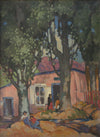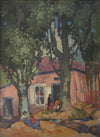
William Penhallow Henderson (1877-1943) Biography
William Henderson first visited Santa Fe as a boy in the early 1880s when his parents' attempt at cattle ranching brought him there. He returned thirty years later to make his permanent home there and create the artwork which would be long remembered.
William's father was an amateur painter and friend of artist William Edward Norton. During his childhood, the family moved several times, but returned to Boston in 1891 where Henderson studied at the Massachusetts Normal Art School and then at the Boston Museum School of Fine Arts in 1899. His instruction there was given by American impressionist painter Edmund C. Tarbell. The next year he won the Paige Traveling scholarship for two years of study in Europe. While there he embarked upon an intense period of self-directed study observing the works of the Old Masters and doing many sketches and paintings. He especially appreciated the work of Velasquez and spent many hours copying his paintings. While in London he met the family of John Singer Sargent and then traveled to Paris, Berlin Madrid, Dresden and the Azores.
He returned to the US and taught at the Academy of Fine Arts in Chicago from 1904 to 1910. He painted in Mexico and Arizona in 1904 with his colleague Carl N. Werntz. This rail trip provided inspiration for thirty works, including some of the first Hopi subject matter that he became famous for in later life. But during this time period most of the work he did to support himself was private portraits. In 1905 Henderson married Alice Corbin who was a well-known poet and assistant editor of Poetry Magazine. They had a daughter in 1907. He completed ten murals between the years of 1906 and 1907 for the Joliet Township High School. The Hendersons wrote and illustrated Anderson's Best Fairy Tales and took their next trip to Europe on the proceeds. In 1914 William was commissioned by Frank Lloyd Wright to design Murals for Midway Gardens in Chicago. He also designed sets and costumes for a Chicago Fine Arts Theater Production. All the while he was continuing to produce a considerable amount of artwork.
When Alice was diagnosed with tuberculosis in 1916, the family moved to Santa Fe for her treatment. Henderson's work went on exhibit in January of 1917 at the Roullier Galleries in Chicago to excited reviews. He was able to capture in vivid color the New Mexico light and became of the of the founders of the New Mexico Painters Society. His dramatic composition drew people into his landscapes. But despite the favorable reviews, the distance from major art markets affected the sales of his work. He was employed during World War I by the US Shipping Board Emergency Fleet Corporation in San Francisco to paint camouflage onto ship hulls. During the 1920s he formed a building company and designed and built many important buildings and fine furniture in the Santa Fe area. In the mid-1930s he completed easel paintings and six murals on the Santa Fe Federal Court Building for the WPA. He died in Tesuque, New Mexico in 1943.
His work is included in many museum collections including the Denver Art Museum, Eiteljorg Museum of American Indians and Western Art, Hubbell Trading Post National Historic Site, Jonson Gallery of the University of New Mexico and the Smithsonian American Art Museum.
